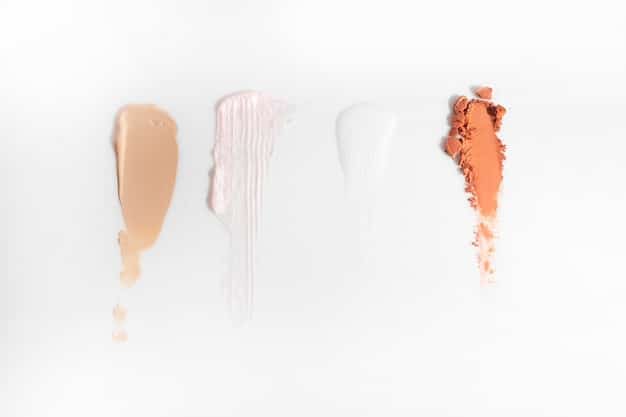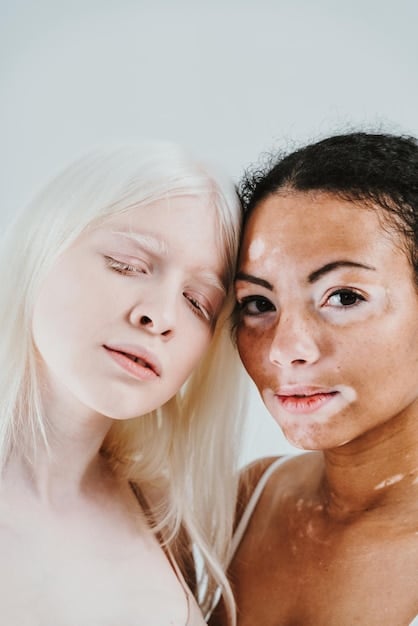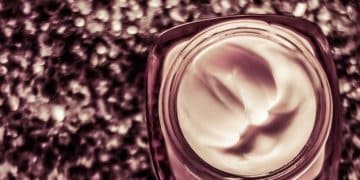The Power of Primers: Find the Perfect One for Your Skin

The Power of Primers: Which One Is Right for You? (Comparison & Analysis) explores the diverse world of makeup primers, helping you understand their benefits and select the ideal formula to enhance your skin’s texture, longevity of makeup, and overall complexion.
Discover The Power of Primers: Which One Is Right for You? (Comparison & Analysis) in this guide, designed to help you choose the perfect primer for a flawless, long-lasting makeup look.
Understanding the Basics of Makeup Primers
Makeup primers are often the unsung heroes of a flawless makeup application. They create a smooth canvas, allowing foundation and other products to glide on evenly and last longer. But with so many options available, understanding the basics and different types of primers is essential.
Primers work by creating a barrier between your skin and your makeup, preventing makeup from sinking into pores or fine lines. This not only improves the appearance of your makeup but also helps to protect your skin from potential irritants in makeup products.
The Key Benefits of Using a Primer
Using a primer offers several distinct benefits that contribute to a better makeup experience.
- Smoother Application: Primers fill in pores and fine lines, creating a smooth surface for foundation.
- Extended Wear: They help makeup stay in place for longer, preventing fading and creasing.
- Improved Texture: Some primers can improve the overall texture of the skin, making it appear more radiant and healthy.
- Protection: Primers act as a barrier, protecting skin from potential irritants and preventing clogged pores.
Ultimately, understanding why you should use a primer is the first step in finding the right one for your needs.
Decoding Different Types of Primers
Navigating the world of primers can be overwhelming due to the variety of formulations available. Each type of primer is designed to address specific skin concerns and deliver unique benefits. Let’s break down the most common types and their ideal uses.
From mattifying primers for oily skin to hydrating primers for dry complexions, there’s a primer designed to suit almost any skin type and concern. Knowing the difference can make all the difference in your makeup routine.

Mattifying Primers for Oily Skin
Mattifying primers are formulated to control oil production and minimize shine, making them ideal for those with oily or combination skin.
- Oil Control: These primers contain ingredients that absorb excess oil, keeping the skin matte throughout the day.
- Pore Minimization: Many mattifying primers help to minimize the appearance of pores, creating a smoother-looking complexion.
- Long-Lasting Makeup: By controlling oil, these primers help makeup stay in place longer, preventing it from sliding off.
If you struggle with excess shine, a mattifying primer can be a game-changer.
Hydrating Primers for Dry Skin
Hydrating primers are designed to add moisture to the skin, making them perfect for those with dry or dehydrated complexions.
These primers often contain ingredients like hyaluronic acid and glycerin, which attract and retain moisture. They help to create a dewy, healthy-looking base for makeup application.
Illuminating Primers for Dull Skin
Illuminating primers impart a subtle glow to the skin, making them an excellent choice for those with dull or lackluster complexions.
- Radiant Finish: These primers contain light-reflecting particles that create a luminous, glowing effect.
- Even Skin Tone: Many illuminating primers also help to even out skin tone, reducing the appearance of redness and discoloration.
- Versatile Use: They can be worn alone for a natural glow or under makeup for a more radiant look.
For a healthy, radiant complexion, consider adding an illuminating primer to your routine.
Color-Correcting Primers: Addressing Specific Concerns
Color-correcting primers are designed to neutralize specific skin concerns, such as redness, sallowness, or dark spots. They use the principles of color theory to visually correct imperfections and create an even base for makeup.
Understanding which color to use for each concern is crucial for achieving the desired results. Let’s explore the different colors and their specific uses.

Green Primers for Redness
Green primers are used to neutralize redness caused by conditions such as rosacea, acne, or sunburn. The green tint counteracts the red tones, creating a more even complexion.
- Neutralizes Redness: Green primers effectively reduce the appearance of redness, creating a calmer, more balanced skin tone.
- Targeted Application: They can be applied to specific areas of redness or all over the face for overall correction.
- Suitable for Sensitive Skin: Many green primers are formulated with soothing ingredients that are gentle on sensitive skin.
If redness is a concern, a green primer can provide significant relief.
Silicone vs. Water-Based Primers: What’s the Difference?
When choosing a primer, it’s essential to consider whether it’s silicone-based or water-based, as this can affect its compatibility with other makeup products and its suitability for different skin types.
Silicone-based primers create a smooth, velvety texture on the skin, while water-based primers are more lightweight and hydrating. Understanding the difference can help you make the best choice for your skin.
Understanding Silicone-Based Primers
Silicone-based primers contain ingredients like dimethicone and cyclomethicone, which create a smooth, silky feel on the skin. They are known for their ability to fill in pores and fine lines, creating a flawless canvas.
They can sometimes cause issues for those with acne-prone skin, so patch testing is always recommended.
How to Choose the Right Primer for Your Skin Type
Selecting the right primer for your skin type is crucial for achieving the best results. Different skin types have different needs, and using the wrong primer can lead to issues like breakouts, dryness, or excessive shine.
Consider your skin’s unique characteristics and choose a primer that addresses your specific concerns. Here’s a guide to help you make the right choice.
For Oily Skin
* Look for: Mattifying primers with oil-absorbing ingredients.
* Avoid: Primers with added oils or heavy, creamy formulations.
For Dry Skin
* Look for: Hydrating primers with ingredients like hyaluronic acid or glycerin.
Application Techniques for Primers
The way you apply your primer can significantly impact its effectiveness. Proper application techniques ensure that the primer is evenly distributed, providing a smooth base for makeup and maximizing its benefits.
From using the right amount to applying it in the correct direction, these tips will help you get the most out of your primer and achieve a flawless makeup look.
Step-by-Step Guide to Applying Primer
Follow these steps for a perfect primer application:
- Cleanse and Moisturize: Start with a clean, moisturized face. Allow your moisturizer to fully absorb before applying primer.
- Apply a Small Amount: Use a pea-sized amount of primer for your entire face.
- Even Distribution: Gently massage the primer into your skin, focusing on areas with pores or fine lines.
- Wait Before Applying Makeup: Allow the primer to set for a few minutes before applying foundation.
By following these steps, you can ensure an even, long-lasting makeup application.
| Key Point | Brief Description |
|---|---|
| ✨ Primer Basics | Enhance makeup application & longevity. |
| 💧 Hydrating Primers | Ideal for dry skin, adds moisture. |
| 🌿 Mattifying Primers | Control oil and minimize shine. |
| 🎨 Color Correcting | Neutralize redness, sallowness, dark spots. |
FAQ
▼
The main purpose of a makeup primer is to create a smooth base for makeup application, helping it last longer and preventing it from settling into pores and fine lines.
▼
Consider your skin’s needs: hydrating for dry skin, mattifying for oily skin, and color-correcting for specific concerns like redness or sallowness. Always choose primers formulated for your skin type.
▼
Yes, you can use primer alone to create a smooth, even complexion. Many primers offer additional benefits like hydration or oil control, making them effective for a natural look.
▼
Silicone-based primers can be beneficial for creating a smooth surface, but they may clog pores for some. If you have acne-prone skin, opt for non-comedogenic or water-based primers.
▼
Apply a pea-sized amount to clean, moisturized skin. Gently massage it in, focusing on areas with pores or fine lines. Allow it to set before applying other makeup products.
Conclusion
Choosing the right primer involves understanding your unique skin type and the specific benefits offered by different formulations. Whether you opt for a hydrating, mattifying, color-correcting, or silicone-free option, the right primer can transform your makeup routine and leave you with a flawless, long-lasting complexion.





